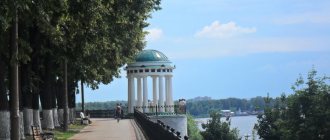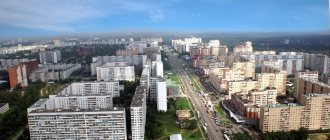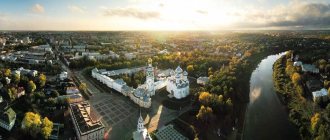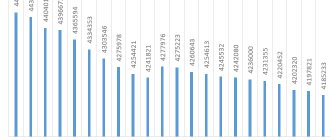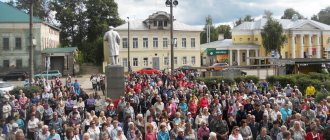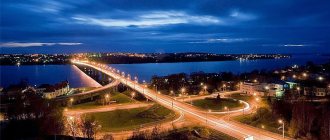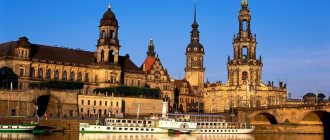The Vladimir region is famous for its rich history and abundance of interesting sights. At the same time, the region cannot boast of its numbers and size. Its area is 29,084 km² - 66th in the list of subjects of the Russian Federation. The population is also small - 1,365,384 residents, which puts the region in 42nd place in the all-Russian ranking. The population density is quite high: 46.95 people. people/km²: six times higher than the Russian average. The density is approximately the same as in the Ivanovo region, two times higher than the Sverdlovsk and Leningrad regions, but almost 4 times less than the Moscow region. The population of the region is declining annually through natural decline and the outflow of young people to other regions.
What holiday is it today?
February 10, 2022, Thursday
Today are holidays, events: Diplomat's Day Tomorrow: World Sick Day Discovery of insulin
Today is the Orthodox holiday: St. Ephraim the Syrian. Venerable Ephraim of Novotorzhsky. Venerable Ephraim of Pechersk, Bishop of Pereyaslavl. Venerable Theodosius of Totem, Spasosumorin of the monastery, leader and founder... Tomorrow: Transfer of the relics of the holy martyr Ignatius the God-Bearer. Saints Gerasim, Pitirim, Jonah, bishops of Great Perm, Ustva...
Today is a national holiday: Ephraim's Day... Tomorrow: Lawrence's Day
Seasons
Seasons, four periods of the year (spring, summer, autumn and winter) characterized by certain average temperatures. The period during which the Sun passes through one of these sectors is called the season. Spring in the Northern Hemisphere and autumn in the Southern Hemisphere begin when the Sun passes through the initial circle of declination and its right ascension is 0° (vernal equinox). Summer in the Northern Hemisphere and winter in the Southern Hemisphere occur when the sun's right ascension is 90° (summer solstice). Autumn in the Northern Hemisphere and spring in the Southern Hemisphere begin when the sun's right ascension is 180° (autumnal equinox). The beginning of winter in the Northern Hemisphere and summer in the Southern Hemisphere is considered to be the winter solstice, when the direct ascension of the Sun is 270°... Next: Seasons. Russian folk calendar. Monthly words...
Folk calendar about every day
Every day one season always replaces another and this determines a person’s way of life. In connection with this, a folk calendar was formed in which there were practically no nameless, unmarked days. Every day was special, had its own purpose. All this was determined by climate conditions and astrological phenomena.
A calendar is a system for counting periods of time. The first calendars arose a long time ago, in ancient times, because there was a need to measure time. The word calendar comes from the Latin words caleo - to proclaim and calendarium - debt book. This is due to the fact that in Ancient Rome the beginning of each month was especially proclaimed, and because it was customary to pay debts on the first day of the month. Different peoples counted time differently. Some calendars are based on the changing phases of the moon - lunar calendars; in others - the change of seasons - sunny; in others, the length of the year was coordinated with the change of seasons, and the counting of months was associated with the phases of the Moon. Such calendars are called lunisolar.
In Rus', the calendar was called a monthly calendar. Every day, the month book covered the entire year of peasant life, “describing” day by day, month after month, where each day had its own holidays or weekdays, customs and superstitions, traditions and rituals, natural signs and phenomena. The cyclical nature of the calendar is reminiscent of human life, where spring is youth, summer is heyday, autumn is the time of harvesting fruits (it’s good if there are some, otherwise you can live your life without collecting fruits), winter is the time of wisdom and peace. This cyclicality and rhythm determined the way of life of the farmer. The folk calendar was an agricultural calendar, which was reflected in the names of the months, folk signs, rituals and customs. Even the determination of the timing and duration of the seasons is associated with real climatic conditions. Hence the discrepancy between the names of the months in different areas... Next: Folk calendar...
The largest cities in the Vladimir region by population
The small region includes 23 cities, among which there is not a single million-plus city. The largest in population, area and density is the capital of the region - ancient Vladimir, where 357,024 people live. Two more settlements boast a population of more than 100,000. The rest cannot be called large: in 17 towns the number of residents does not exceed 10,000. The region is dominated by urban population, accounting for almost 80% of the total.
The most densely populated in the Vladimir region include:
- Vladimir - 357 024.
- Carpets - 138,552.
- Murom - 109,809.
- Alexandrov - 59,328.
- Gus-Khrustalny - 55,421.
- Kolchugino - 43,543.
- Vyazniki - 36,635.
- Kirzhach - 27,157.
- Yuryev-Polsky - 18,610.
- Rainbow - 18,535.
Fishing calendar for every day
The fishing calendar should not be taken as an absolutely indisputable truth. Fish biting is greatly influenced by a whole range of natural factors, as well as the influence on the nature of man himself. You must not forget that the fish’s bite depends and is determined not only by the calendar dates and biological cycles of their life, reflected in the calendar, but also, no less, by the state of their habitat; the bite also depends on weather conditions: air and water temperatures, cloudiness, wind direction and strength, etc... Next: Fishing calendar...
Suzdal - a fairy-tale city
| The city where most Russian films are shot. A city with a special atmosphere of warmth and comfort. |
When Yuri Dolgoruky
made
Suzdal
the capital of North-Eastern Russia, Moscow was not in the project. Suzdal is already more than 1000 years old, but the city has still retained its ancient appearance and even its borders. The town is tiny by our standards - its area is only 10 square kilometers. 200 churches and temples are crammed into this modest territory, making the city seem like one big open-air museum...
The soul and heart of the “Golden Ring” is how Suzdal is poetically called. “Open Air Museum” is another name for this glorious city, where more than 200 ancient monuments are located in a small area. Colorful Suzdal is one of the few truly Russian cities that have managed to preserve the charm of antiquity, this unique spirit of Slavic traditions, amazing architecture and the warm aura of holy places. The history of the city dates back to the 11th century. Like many Russian cities, Suzdal was built on the river (Kamenka) as a defensive fortress guarding state borders. A powerful fortress - the Suzdal Kremlin - becomes the beginning of a new city.
In 1024, the chronicle first mentioned Suzdal. And it is not surprising, because at this time it became a large and developed city in the northeast of Kievan Rus. And in the middle of the 11th century it reached its greatest prosperity and became the capital of the Rostov-Suzdal principality. Yuri Dolgoruky became the first Suzdal prince. But his heir, Andrei Bogolyubsky, moved the capital of the principality to Vladimir. And then Suzdal suffered greatly from the Mongol invasion.
The next stage in the life of Suzdal was its entry into the Principality of Moscow at the end of the 15th century. The beginning of the 16th century brought many trials to the Suzdal land. In 1608 and 1611 the city was captured by the Poles twice. In 1634, the city was subjected to devastating raids by the Crimean Tatars, then a devastating fire in 1644 destroyed the entire western part of the settlement, and in 1654-1655. The “pestilence” epidemic plunged the city into desolation for a long time. But already in the 17th century, intensive construction began in the city. At this time, all currently existing ensembles were erected, the best of which were the architectural structures of the ancient Kremlin, Pokrovsky and Spaso-Evfimev monasteries.
The history of Suzdal is full of tragic pages, but the surprising thing is that each time the city rose and shone more beautiful than before. Maybe the reason is that Suzdal is a truly holy land, replete with monasteries and temples. Already in the 14th century. there were eight monasteries and at least forty churches in the city. At the end of the 18th century, Suzdal became a district town of the Vladimir region. And in the last century, Suzdal attracted the attention of the whole world thanks to its unique monuments of Central Russian architecture.
Interesting places and architectural monuments of Suzdal: Suzdal Kremlin, Intercession Monastery, Deposition of Robe Monastery, St. Vasilievsky Monastery, Spaso-Evfimievsky Monastery, Nativity Cathedral, Resurrection Church, Kideksha Church, Museum of Wooden Architecture and much more.
- .
Orthodox calendar about every day
Orthodox calendar: Orthodox, Church and Christian holidays.
The church year is an alternation of weekdays and holidays. On weekdays, a person is called to work “by the sweat of his brow to earn his bread.” Holidays are given in order to feel liberation, to rise above the bustle and routine of the world, to feel involved in the highest of worlds, “where there are no illnesses, sorrows and sighs, but endless life.” Since ancient times, holiday cycles have been associated with the seasons. The pagans associated them with the worship of the forces of nature, the cult of which in the Old Testament was replaced by gratitude to the Creator for the universe. And although the connection between holidays and the seasons has not completely lost its power, since God is present in everything, in the plant and animal world, in human works, it nevertheless faded into the background, giving way to a spiritual foundation built on the Sacred Scriptures. The history of Orthodox holidays dates back to the times of the Old Testament. Each of the Orthodox holidays is dedicated to the remembrance of the most important events in the life of Jesus Christ and the Mother of God, as well as the memory of saints... Next: Orthodox calendar...
Murom - large and touristic
Three times fewer people live in Murom than in Vladimir: 109,809, but the density is almost the same and is 2508.2. In fact, it is even older than the capital of the region: the first mentions date back to 862, but the settlement itself arose much earlier. Unfortunately, most of the ancient buildings have not reached us due to fires. However, tourists still strive to visit this cozy town, which in 2013 was recognized as the most comfortable in the region. It occupies third position in the ranking in terms of number of residents and size.
Since 2000, the number of Murom residents has been steadily declining, and at a fairly high rate: by 2022, the figure has decreased by almost 35,000. This is due not only to natural decline, but also to the general trend of urbanization. Young people leave for Vladimir, Moscow, St. Petersburg and other large cities to study, in search of work and opportunities for self-realization. It is interesting that before this, over the course of a whole decade, the number increased due to the influx of people from surrounding rural settlements.
There is a well-developed public transport network here. Thanks to the relatively small number of residents, traffic jams, although they occur, are not prolonged. Maximum traffic is observed in the summer, when Murom becomes a magnet for excursion groups. Although there are several industrial enterprises here, they do not cause significant harm, but they make a serious contribution, along with tourism, to the economy of the locality.
Russian folk calendar for every day
The word “sign” comes from the word “notice”, i.e. observe. As a result of observing what happens around a person every day, he accumulates life experience. This knowledge was passed down from generation to generation, carefully preserved and people trusted it as a sacred book. Many signs have come to us from the depths of centuries without losing their knowledge. Each of us is free to choose: to dismiss all this as an absurd superstition or to take a closer look at the signs and take the centuries-old experience of generations more seriously. Most of us, when taking exams, ask them to scold them, boasting about some kind of good fortune or luck, spit so as not to jinx them or knock on wood, take a detour if a black cat crossed the road, are afraid of the number 13 and much more. And who among us does not have lucky things, numbers? Who has never resorted to the help of fate at least once in their life, who has not believed in secrets? It’s as if everything connected with signs is hidden somewhere deep in our subconscious. Often we remember them mechanically, unconsciously, or just as a joke. But, undoubtedly, the signs contain a lot of accurate knowledge and practical wisdom of our ancestors. They cover all the characteristic, often difficult to perceive, natural phenomena. Signs have preserved a lot of what was in old folk holidays and customs; they help predict the weather, grow crops... Next: Folk signs...
Kovrov is large within the region
On the second line of the list is Kovrov, where half the population lives than in the regional center. It occupies the same position in the top of large ones with an area of 57.4 km². In terms of density it is on the third line with a value of 2413.8: in Murom this figure is, albeit slightly, higher. It is worth noting the presence of many suburbs, which forms a fairly densely populated urban agglomeration of about 200,000.
The settlement was founded in the 12th century by Yuri Dolgoruky: then it was considered a small village called Elifanovka. The real history began only under Catherine the Great, who gave it the status of a county town and a new name. Since then, the population has rapidly increased, the maximum jump occurred in the 30-70s of the last century.
Holiday calendar, dates and events of the year
All state and professional holidays in Russia, including significant World and International holidays, and other equally interesting holidays and events about every day.
The holiday has always kept pace with the history of mankind. Social time can be divided into three types: everyday life (weekdays), weekends and holidays. Everyday life is a series of practices repeated day after day and every day (work). Weekends are regular breaks from the rush of everyday life. It is believed that on weekends a person should restore his strength after working days. Day off, non-working day. A holiday is a day of celebration established in honor or in memory of someone or something. A day or series of days celebrated by the church in memory of a religious event or saint... Next: Calendar...
Prayer book, Orthodox prayers for every day
Prayer is the most powerful means for healing all illnesses - both physical and mental. Prayers can be laudatory or grateful, petitionary and repentant. If we have offended God, sinned, we must ask Him for forgiveness, that is, repent. Such prayers are called repentant prayers. If everything is fine with us, if we and our loved ones are healthy and prosperous, if we have a place to live, something to wear, something to eat, we must glorify and thank God for this. Such prayers are called praise or thanksgiving. If some misfortune, illness, trouble or need happens, you need to ask God for help. Such prayers are called petitionary... Next: Orthodox prayers...
Zodiac, astrological, eastern calendar. Zodiac signs
In ancient times, to establish the calendar, priests used knowledge of the positions of all the planets. Before the reform of Peter 1, the New Year was celebrated on the Day of the Autumn Equinox. On this day, according to ancient legend, the most peaceful treaty was concluded between the Great Race (ancient Slavs) and the Great Dragon (ancient Chinese) and it was approximately 7518 years ago... For the ancient Slavs, the calendar month corresponded to the lunar cycle from new moon to new moon, taking into account such Thus, the relationship of the entire annual cycle with astronomical and natural phenomena. There was no coherent calendar system. The main natural phenomena are still considered to this day to be the days of the solar equinox and solstice - the Slavic holidays Maslenitsa, Kupala, Ovsen and Kolyada. But during the time of Peter 1, all ancient Slavic calendars were abolished and a new Western European calendar from the Nativity of Christ (Julian calendar) was introduced, while the beginning of the calendar was moved to January 1. The Julian calendar (old style) did not take leap days into account and accumulated one extra day every 128 years. After the October Revolution in 1918, the Gregorian calendar (new style) was introduced in Russia, according to which an amendment of 13 days was introduced. The calendar of the ancient Slavs was based on two planets: the Sun and the Moon. And now they don’t use anything at all. The calendar has become static. There is no such thing as the calendar, it turns out, resting on some planet. Nobody even knows about it. There are just some standard numbers, there are months and holidays. The calendar is based on the Sun and Moon. Why is this so? Because these two luminaries influence the Earth. The Earth revolves around the Sun, and the Moon revolves around the Earth. And these two luminaries create the atmosphere on the planet. From here the calendar is built... Next: Astrological calendar...
Vladimir is the largest in the region
Vladimir, without a doubt, can be called one of the cradles of the formation of Russian statehood: formed in 990, since the 12th century it has acted as the capital of the influential Grand Duchy of Vladimir. Today it is part of the Golden Ring route, being the main pearl, thanks to which the settlement receives a fairly high tourist flow all year round.
Among all the settlements in the region, Vladimir has the maximum demographic indicators:
- area - 137.014 km²;
- number - 357,024;
- density - 2605.75 people/km².
The latter figure for a regional city is quite high, which is why there are problems with traffic jams. The most difficult situation is in the central neighborhoods, where a significant concentration of cars cannot comfortably move along the ancient narrow streets, and it is also difficult to find a parking space. The situation becomes more complicated in the summer and during the holidays, at the peak of tourist activity: groups of tourists who come on excursions on large buses often impede general traffic.
Also among the problems of Vladimir is the poor ecology: it is among the top 100 most polluted in Russia, and is considered the most unfavorable in this regard for living among other settlements in the region. The atmosphere suffers most seriously from emissions from industrial enterprises, followed by car exhaust gases and landfills. The permissible level of nitrogen dioxide in the air was 13 times higher, and substances such as phenol, benzopyrene, sulfur dioxide and formaldehyde were recorded. There are more than 15 large enterprises operating in the following industries:
- food;
- chemical;
- energy;
- metallurgical;
- light;
- mechanical engineering.
Throughout development, the population continued to increase regularly, with the exception of a slight decline in the nineties of the last century. Since 1599, when 1,200 people lived here, the figure has increased 300 times, and from 2013 to 2022 the number of residents has increased by 10,000. For the most part, this is due to the influx of people from small settlements in the region, traveling for career prospects and income opportunities .
Dream books online, interpretation of dreams
A dream book is nothing more than an interpreter of dreams and dreams, a translator of dreams. Since ancient times, people have been using dream books; dreams have always been given great importance, and people have often noticed the prophetic properties of some dreams. The dream book can become your faithful assistant every day and throughout your life, thanks to the dream interpreter you can always make the right decisions, the dream book will help you resist temptations in time, and will warn you against wrong steps and frivolous actions. Further…
Vladimir region on the map of Russia
You can find the Vladimir region on the map and plot a route using your navigator using the coordinates (55.904195, 40.898894). In the north, it borders with the Yaroslavl region, in the north-west and west - with the Moscow region, in the north-east with the Ivanovo region, in the east - with the Nizhny Novgorod region. To the south is the Ryazan region.
